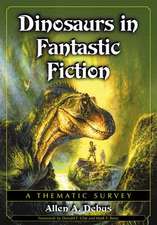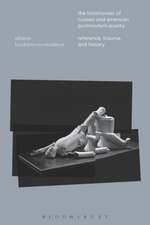David Foster Wallace: Fiction and Form
Autor Dr. David Heringen Limba Engleză Paperback – 17 mai 2017
| Toate formatele și edițiile | Preț | Express |
|---|---|---|
| Paperback (1) | 178.22 lei 6-8 săpt. | |
| Bloomsbury Publishing – 17 mai 2017 | 178.22 lei 6-8 săpt. | |
| Hardback (1) | 714.12 lei 6-8 săpt. | |
| Bloomsbury Publishing – 7 sep 2016 | 714.12 lei 6-8 săpt. |
Preț: 178.22 lei
Preț vechi: 207.26 lei
-14% Nou
Puncte Express: 267
Preț estimativ în valută:
34.11€ • 37.07$ • 28.67£
34.11€ • 37.07$ • 28.67£
Carte tipărită la comandă
Livrare economică 21 aprilie-05 mai
Preluare comenzi: 021 569.72.76
Specificații
ISBN-13: 9781501330568
ISBN-10: 150133056X
Pagini: 216
Ilustrații: 1 b/w illustration
Dimensiuni: 152 x 229 x 19 mm
Greutate: 0.32 kg
Editura: Bloomsbury Publishing
Colecția Bloomsbury Academic
Locul publicării:New York, United States
ISBN-10: 150133056X
Pagini: 216
Ilustrații: 1 b/w illustration
Dimensiuni: 152 x 229 x 19 mm
Greutate: 0.32 kg
Editura: Bloomsbury Publishing
Colecția Bloomsbury Academic
Locul publicării:New York, United States
Caracteristici
Traces Wallace's formal development and his growing influence upon a generation of writers
Notă biografică
David Hering is Lecturer in English at the University of Liverpool, UK.
Cuprins
Acknowledgements Introduction Chapter 1 Vocality "A Flickering Hand, Dead and Cold": Reading Wallace's Ghosts Chapter 2 Spatiality "In the Middle of the Middle of Nowhere": Regionalism and Institutions Chapter 3 Visuality "Seeing by Mirror-Light": Wallace on Reflection Chapter 4 Finality "Not Even Close to Complete": The Many Forms of The Pale King Works Cited
Recenzii
There's a chapter devoted to Wallace's evolving articulation of voice, of space and of vision, respectively. Taken individually, these three chapters deepen our appreciation of Wallace's work and its development. Taken together, they provide Hering with grounds for specifying, in the final chapter, just how 'incomplete' the published version of The Pale King can be taken to be.
Quality as well as quantity characterize the scholarship in David Hering's David Foster Wallace: Fiction and Form. Hering is comprehensive in treating the author's work from four complementary perspectives: vocality, spatiality, visuality, and finality.
Since the death of David Foster Wallace, we have been waiting for a comprehensive study of his literary career, its trajectory and achievements. Through in-depth study of Wallace's published works and extensive archive, David Hering brilliantly anatomizes the author's writing via themes of vocality, visuality and spatiality. The book's final chapter, a forensic reconstruction of the drafting process for The Pale King, tells a whole new story of Wallace's creative life over his final years. An exhilarating read for fans and scholars alike, David Foster Wallace: Fiction and Form represents the most significant step forward in Wallace studies for at least a decade.
David Hering offers a highly insightful study of questions of vocality (specifically, analyzing 'possession' as a model for authorial presence), spatiality (discussing regionalism and institutionality) and visuality (that is, modelling different forms of reflection and refraction) in the work of David Foster Wallace. Subsequently, these questions are connected to a revelatory chronology of the composition of Wallace's unfinished novel The Pale King, making Hering's monograph invaluable reading for all scholars interested in the development of Wallace's fiction.
Quality as well as quantity characterize the scholarship in David Hering's David Foster Wallace: Fiction and Form. Hering is comprehensive in treating the author's work from four complementary perspectives: vocality, spatiality, visuality, and finality.
Since the death of David Foster Wallace, we have been waiting for a comprehensive study of his literary career, its trajectory and achievements. Through in-depth study of Wallace's published works and extensive archive, David Hering brilliantly anatomizes the author's writing via themes of vocality, visuality and spatiality. The book's final chapter, a forensic reconstruction of the drafting process for The Pale King, tells a whole new story of Wallace's creative life over his final years. An exhilarating read for fans and scholars alike, David Foster Wallace: Fiction and Form represents the most significant step forward in Wallace studies for at least a decade.
David Hering offers a highly insightful study of questions of vocality (specifically, analyzing 'possession' as a model for authorial presence), spatiality (discussing regionalism and institutionality) and visuality (that is, modelling different forms of reflection and refraction) in the work of David Foster Wallace. Subsequently, these questions are connected to a revelatory chronology of the composition of Wallace's unfinished novel The Pale King, making Hering's monograph invaluable reading for all scholars interested in the development of Wallace's fiction.
























